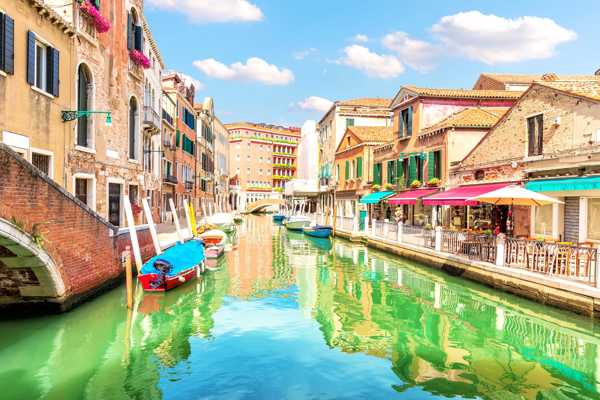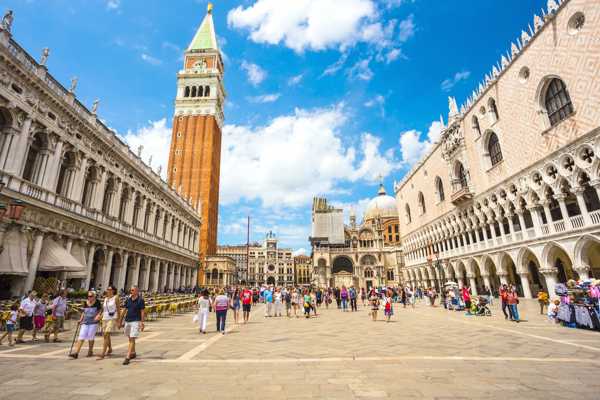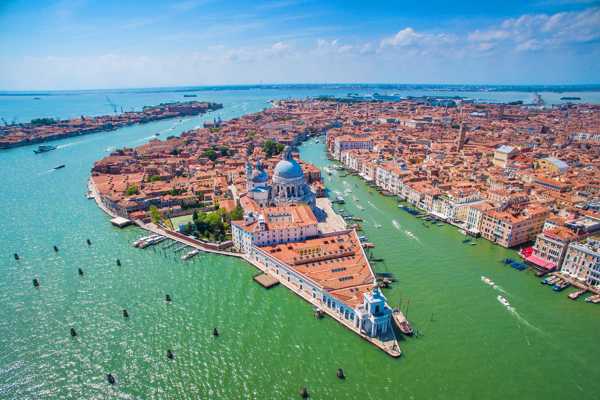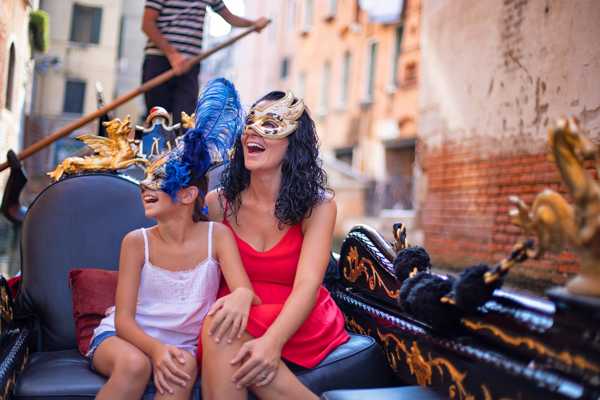Despite the hordes of tourists that flood Venice’s streets, there are still parts of the city that retain that magical village feeling that is raved about in films and books. With her quaint backstreets and colourful clusters of buildings, Venice is much more than just gondola rides and romance (although it does have those things). Pockets of magic still exist – believe or not – even in congested areas such as San Marco.
The best times to visit Venice are either between May and June or September to October, when it’s less crowded and the weather’s still pleasant. Some things to remember for your visit: stand at the bar at restaurants to avoid steep prices, always walk on the right, and take the vaporetto (water taxi) instead of the gondola. Below is a comprehensive guide to the city’s 6 districts (or as they call them, sestieri), picking out only the places that locals love.
- 1
San Marco
Find the secret spots in the most congested part of Venice

As you might expect, locals tend to avoid San Marco because, as the tourist heart of the city, it’s almost always ridiculously crowded. Despite this, there are a few spots in the neighbourhood that locals brave the crowds for. Bright and early, head to Rosa Salva for a speedy breakfast. This bakery serves intense coffee and tasty almond croissants. Locals tend to be in an out in a minute, so don’t linger.
For a little hit of art, Palazzo Fortuny is a fascinating museum housed in a great example of Venetian Gothic architecture. Given the extortionate prices in San Marco, the reasonable rates at Ai Mercanti make it quite a rarity. Found between the Rialto Bridge and Piazza San Marco, this upscale restaurant serves classically-inspired Venetian dishes, which change every 2 months. Few people go to Harry’s Bar for the food, but locals frequently pop in for a Bellini at the beginning of their evening.
地圖 - 2
Cannaregio
The historical heart of local Venice

Cannaregio boasts a strong community and has remained largely unchanged by the city’s crowds. This sestiere covers a large area above Canal Grande – one of the main water corridors of Venice – and holds much of the city’s history and authenticity. The best way to explore this neighbourhood is on foot, which will take you around beautiful buildings, the Jewish Ghetto and lots of excellent bars and restaurants.
Walk across Ponta degli Scalzi – one of only 4 bridges that cross Canal Grande – and watch all the boats zooming up and down the waterway. Head over to Cantina Aziende Agricole for a coffee and a few cicchetti (small savoury snacks). The Jewish Ghetto is steeped in captivating history, being the first ghetto in the world and home to 3 of the oldest synagogues in the world. There are also amazing artisan shops in this area. Plum Plum Creations is a workshop that continues the ancient printmaking tradition of Venice. From mid-May until the end of November, many palazzos open especially for the Biennale. Check its website to see which palazzos are involved and what exhibitions are on.
For local food and live music, head to Paradiso Perduto. For a young Venetian crowd and impromptu jazz music, go to Al Timon. At Cicchetteria Venexiana Da Luca e Fred, locals flock to order the dish of the day, which comes out steaming hot at around noon (and is usually risotto). Ostaria da Rioba and Cà D'Oro alla Vedova are considered classic dinner options. For the most lethal spritz in town, go to Dodo Caffé. Other good drinking spots are Ai biliardi, Cantina Aziende Agricole (again) and 10 Metri Quadrati.
地圖 - 3
San Polo
Local markets and cool meeting spots just steps from the Canal Grande

While San Polo has heavily trodden banks lining the Canal Grande, its labyrinthine streets, filled with dusky cafés, slows down the pace and sets itself apart from neighbourhoods like San Marco. Santa Maria Gloriosa dei Frari is a gorgeous, often-overlooked church that holds a small collection of exquisite Italian masterpieces. Nearby is another local favourite for art – Scuola Grande di San Rocco. This grandiose building houses magnificent pieces by Italian painter Tintoretto.
Mercati di Rialto is a favourite meeting place for Venetians, who come to get the freshest and best fish from the Adriatic and grab an ombra (a small glass of wine) with their friends. It’s safe to say this market will continue to be a hotspot for years to come. A word of warning about the noisy fishmongers: Do not touch their produce, even if you mean to buy it. Only point to what you want. Once you’ve wandered around this vibrant market, pop over the Rialto Bridge to T Fondaco dei Tedeschi, which hosts gorgeous views of the canal and the city. The terrace is free to enter.
Local favourites for food include All’Arco – a tiny bacaro (Venetian version of an osteria) that opens only for lunch. Try the hot sandwich of boiled beef sausages to warm you up in winter. Just around the corner is Cantina Do Mori, said to be the oldest bacaro in the city, dating to 1462. Make sure to try the house special, francobollo. At the closet-sized Al Mercà, choose from one of the 50 types of wine on offer. Come early in the evening if you want a spot by the bar. At Il Muro, you can get delicious Venetian cuisine and a glass of wine for roughly €10.
地圖相片由 london road 提供 (CC BY 2.0) (經修改)
- 4
Dorsoduro
Where students go to eat, drink and be merry

In Dorsoduro, you won’t tire of things to do. This neighbourhood is brimming with youth and culture and is at the forefront of the city’s arts scene. Once home to cotton mills and factories, there’s a certain rustic charm that permeates throughout its streets. Many universities are found here, so don’t be surprised to see a lot of young people, especially at Campo Santa Margherita, come aperitivo. Art lovers will thrive here, with the Peggy Guggenheim Collection, the Gallerie dell’Accademia, the Fondazione Vedova and the Fondazione Pinault all within your grasp.
In the mornings, pay either Pasticceria Tonolo or Dal Nono Calussi a visit and start your day with a focaccia Veneziana – a sugar-coated panettone-like cake – and an espresso. Other local spots include Campo San Barnaba for a quieter aperitivo and Squero di San Trovaso, which is one of the few gondola boatyards left on the island. Here, you can see how this iconic boat is made, while sipping on prosecco and enjoying cichetti. Close by is Al Bottegon (as the locals call it) and Al Squero.
Dorsoduro is meant to be the sunniest part of the city, so a walk along the charming Fondamenta delle Zattere towards Punta della Dogana should top off your tan. Along the way, stop at Gelateria Nico to try their amazing praline and cream. A nice spot to end the day is Punta della Dogana, which overlooks the Bay of San Marco and the entrance point of the Canal Grande and Canal di Giudecca – the main canals of Venice. Al Chioschetto has the usual spritz and excellent live music. For dinner, head to Osteria Enoteca Ai Artisti, Osteria Ai Do Farai or Al Profeta. For Venice’s most exciting nightlife, you should head back to the bars on Campo Santa Margherita, especially Ai Do Draghi.
地圖 - 5
Castello
Head out east to see Venice's great exhibitions

Castello is the easternmost part of the city and is said to be Vivaldi’s old stomping ground. This sestiere developed all around the Arsenale – the ancient and once-vital shipyard – into one of the most picturesque areas of the city. The canals of Castello run alongside lush green spaces and stunning churches dating back to the 1200s. You can see locals’ laundry draped on clotheslines zig-zagging across the watery roads – a particularly snap-worthy scene.
The most notable attraction in the area is the Art Biennale, which is held biennially, on odd-numbered years. The Biennale of Architecture is held on the even-numbered years. The exhibits and pavilions are found in the Giardini and Arsenale and is usually held from mid-May until the end of November. For a truly magical hideaway, go to San Piero De Casteo – a small island with a tranquil church. Take a stroll around here and get lost in its beauty.
Don’t forget to stop for your obligatory gelato at La Mela Verde and try the stracciatella. Excellent wine bars include El Refolo and Vecio Trani, which are next to each other. For dinner, L’Osteria di Santa Marina is your best option.
地圖 - 6
Santa Croce
The quiet, sleepy corner in the west

Santa Croce probably doesn’t get as much attention as it should. We’ll admit that most signs don’t seem to indicate this area as worthy of a visit, but if you know where to look, you’ll find yourself pleasantly surprised. This is an area of contrasts, with the fumes of the bustling Piazzale Roma, but also the slow magic of one of Venice’s loveliest little squares, Campo San Giacomo dell’Orio. This square is basically the local living room, where even tango lessons are held. Walk around aimlessly, following your curiosity, and you’ll come along many quiet canals and sleepy corners of Venice.
Il Refolo is a nice spot to gondola-watch and also has pretty good pizzas. Their outside seating provides a sunny spot to just read or enjoy the scenery. Once you find yourself sweating, get a gelato at Gelateria Alaska, where the gelatista will have you tasting all his latest eccentric creations.
地圖



















